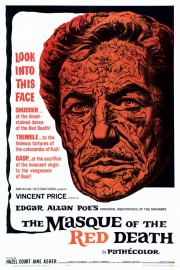The Masque of the Red Death
Though he is best known for low-budget exploitation flicks and B-movies, as well as a mentor to filmmakers like Martin Scorsese, Ron Howard, and Francis Ford Coppola, in the 1960s, Roger Corman churned out a series of eight films adapted from the works of Edgar Allen Poe. Most of them starring Vincent Price, they were made for American Independent Pictures, and established both their maker, and their studio, as a brand in horror to rival Britain’s Hammer Films, or Universal Studios during the ’30s and ’40s. His 1964 film, “The Masque of the Red Death,” is a true masterpiece of the series, and holds up beautifully next to the likes of “Horror of Dracula” or “Bride of Frankenstein.”
Vincent Price gives a great, iconic performance as Prince Prospero, an evil tyrant during the Middle Ages who thinks nothing of asking a woman to choose between her father’s life or her lover’s for his amusement, or burning a village to the ground as the winter approaches. Of course, he has a legitimate reason for the latter: the Red Death has come to the village, and the otherwise unafraid Prospero is scared. He takes the woman (Francesca, played by Jane Asher), her father (Ludovico, played by Nigel Green), and lover (Gino, played by David Weston), to his castle, where he is gathering friends for a masquerade ball, and other forms of decadence. As Francesca will discover, death is not far behind Prospero, a satanist whose faith in his master will be put to the death.
In a way, Corman’s film is one of the few horror films that stares down real terror, real horror. Not many movies do; only Murnau’s “Nosferatu,” Kubrick’s “The Shining,” Friedkin’s “The Exorcist,” and a handful of others come to mind. It’s a little too opulent and beautiful in its use of color and widescreen cinematography to be truly “scary,” but it stares down real evil nonetheless by placing a true believer in God (Francesca) in a situation where only evil seems present. She gets insight into the twisted mind of Prospero through verbal interactions, and watching his casual cruelty, whether it’s executing a “friend” who was late to his castle (risking the Red Death), or putting Gino and Ludovico through a tense, sadistic game where both risk death, but one is forced to sacrifice. What an evil man, but in his way, he is the most rational in the film, and Price– with a wicked charisma that he displayed throughout his career –is a master of elegant, intelligent evil in the role, one of the most memorable in horror history.
But Price’s work in the film isn’t that surprising; Corman’s is. Nowadays, his name is synonymous with schlock like “Sharktopus” and the original “Little Shop of Horrors,” but the Poe films of his I’ve seen, and especially, “The Masque of the Red Death,” show him as a great filmmaker. Two sequences, in particular, stand out: the first is a nightmare where Julianna (Hazel Court), Prospero’s mistress, gives herself over to Satan, has bold hallucinations that will lead her to her death. The second is Prospero’s masque itself, culminating in a haunting, technicolor scene where the Red Death crashes the party, and makes its way through the crowd, turning them into dancers in a death waltz (scored by David Lee, whose work is some of the best in horror movie history) that will leave the faithful unharmed, but take the rest, including Prospero. The choreography of the dancing, and the makeup effects, are brilliant, and end Prospero’s tale on a diabolical note, which is matched on the opposite end by a coda where we see Death’s ambassadors, cloaked and masked, as they reflect on their work, and confirm that hope, and faith, live on, even in the most dire of times. It’s an unusual way for Poe to end, but Corman doesn’t stray from the macabre truth of the great writer’s work, further solidifying his reputation as one of the great, influential storytellers in film history.










